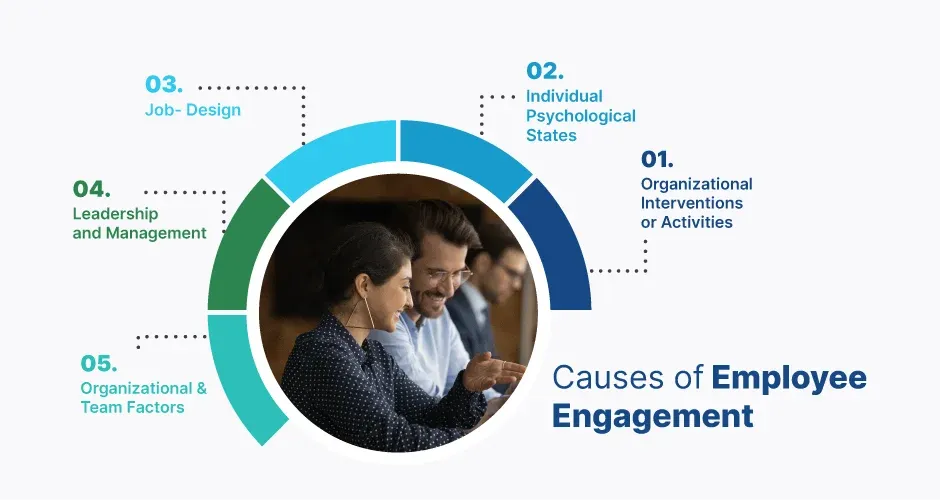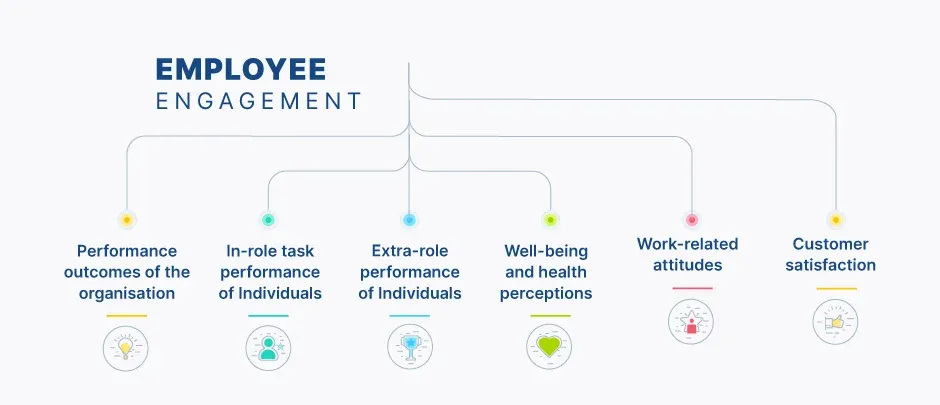Employee Engagement: A Research Perspective
Employee engagement is the enthusiasm and dedication employees have towards their work and workplace. It is emerging as a trend and a necessity in the business world. Explore the blog to understand the meaning, importance, causes, and effects of employee engagement from a research perspective.
On this page
- What is employee engagement?
- The definition of employee engagement from different perspectives
- Case study of Sue Thompson
- Applying the employee engagement definition to Sue’s Story
- Causes and effects of employee engagement
- Various causes of employee engagement
- Effects of employee engagement
- Understanding the difference between an engaged employee and a disengaged employee
- Differentiating employee engagement from other related terms
- How to measure employee engagement?
- Employee engagement strategies
- Empower your employee engagement strategy with Empuls
- Future of employee engagement
Recently, in an executive program on leadership, a professor elicited a lot of laughs by telling the following joke:
“A CEO was asked how many people work in his company: ‘About half of them,’ he responded.”
After the session, several participants put a more serious face on the problem and bemoaned the fact that a significant number of people in their organization had mentally “checked out”.
In other words, “Never mistake activity for accomplishment.”
“The truly engaged employees are attracted to, and inspired (“I want to do this”), committed (“I am dedicated to the success of what I am doing”), and fascinated (“I love what I am doing”) by their work.
Engaged employees care about the future of the company and are willing to invest the discretionary effort – exceeding duty’s call – to see that the organization succeeds.
In short, employee engagement is getting up in the morning thinking, “Great, I’m going to work.” — Tim Rutledge (Author of Getting Engaged: The New Workplace Loyalty)
What is employee engagement?
The internet confidently throws out a gamut of definitions on employee engagement, both practitioners and academic researchers find themselves facing and using ambiguous versions of it.
They are often found using the term ‘employee engagement’ interchangeably as a psychological state, behavior, or trait. This ambiguity is intrinsic to many concepts of the HRM field and there are long-standing debates amongst experts on these definitions.
The definition of employee engagement from different perspectives
There are a number of popular and highly-relevant employee engagement definitions, which are currently defined through three different lenses—the employee, employer, and both.
In other words, a few of them address only the employee’s role in it, a few addresses both the employee and the organization, and a few only the organization.
The employee perspective
1. The job role definition (w.r.t. the symptoms of an engaged employee)
2. The work task definition (w.r.t. the performance of an engaged employee)
The employee + organization perspective
3. The multi-dimensional definition (w.r.t. the employee’s and organization’s performance)
The organization perspective
4. The management practice definition (w.r.t. the organization’s efforts towards employee engagement)
Let us consider a case study that demonstrates the application of these definitions.
Case study of Sue Thompson
(Excerpt from ‘The Talent Masters’, Bill Conaty & Ram Charan)

Part 1: The Employee
Sue has an MBA from Wharton with three years of tech product selling experience at 3M. She graduated top third in her class and spent 2 years at McKinsey in consulting.
Sue joined Lindell Pharmaceuticals in 2006, and they made her the sales manager of the Pennsylvania and New Jersey territory, where she oversaw over a hundred people. After 2 years, she was outperforming all the other territories and setting new records in sales.
In 2008, when pharma selling transformed from product selling to value selling, Sue quickly grasped the reality and set out procedures and metrics required for the new approach. She designed a proprietary system for studying drug usage patterns to give clients insights on improving healthcare while bringing down costs.
Her sales force was put through intensive training exercises and she revamped half of her team with people who have business insights along with pharma selling knowledge. She also had a deep understanding of her customer’s business and their P&L.
Part 2: The Organization
Lindell’s CEO was serious about creating pipelines of future leaders and four of the top executives were out on this task. Sue’s achievements were being watched very carefully. Each of these leaders not only watched these performance numbers but even shadowed Sue during her key client meetings.
They studied how she saw things from the clients’ perspective, giving them key insights through financial analysis. They also adored how Sue enabled effective two-way dialogue with her clients. They learned that she reshaped her job and was now out-growing it.
Even before she anticipated it, the board concluded based on a thorough analysis of her performance to give her a ‘Brand Manager’ role with P&L responsibility. This promotion fast-tracked her ascension towards an executive position and it opened Sue up to an environment that was ideal for her personal and professional growth.
Applying the employee engagement definition to Sue’s Story
- If Kahn (Definition 1) was to observe this event, he would have concluded that the very person that Sue was at work – passionate and constantly pursuing excellence, made her an engaged employee.
- If Schaufeli (Definition 2) was to observe this, he would have concluded that her demeanor at work, the way she delivered results, adapted to dynamic market conditions, and engaged with her clients showed how engaged an employee she is.
- If Saks and Selmer (Definition 3) were to observe this tale of Sue, they would have added how her entire team performed and grew and how the organization facilitated this process.
- If Definition 4 was to be put to use, Sue’s story would have been a demonstration of Lindell’s culture of nurturing leadership and intently monitoring talent (in other words, their employee engagement strategy), which resulted in the extraordinary recognition of Sue’s achievements.
Likewise, these definitions are schools of thought that attempt to capture employee engagement from their respective scopes. Though each of these has definitive differences, all intend to derive that an engaged employee leads to an optimized functioning of the workplace.
Causes and effects of employee engagement
The limitation of all these definitions is that they fail to address whether the engagement indicators are causes or effects of an engaged employee.
Catherine Bailey, Adrian Madden, Kerstin Alfes, and Luke Fletcher conducted their very popular 2017 study that included a narrative synthesis reviewing over 6000 primary pieces of research done on employee engagement. They extracted five causes and five effects of employee engagement from these studies.
Various causes of employee engagement

It is important to understand the engagement indicators that are caused so as to understand the ‘controllable’ portion of the employee engagement equation. These factors, as identified by the study after eliminating thousands of others for insignificance, are listed below.
1. Individual psychological states (personal resources)
The employee’s individual psychological characteristics are found to play a great influence on their state of engagement. It is found that the positive perceptions that individuals hold of their personal strength and ability allow them to be engaged with the organization.
- Self-efficacy: An individual’s sense of self-efficacy, in other words, how he/she can be of use to the organization seems to play the most significant role amongst the individual psychological factors.
- Resilience: The ability of an individual to quickly learn and adapt to the demands of a job and the organization is another strong influencer to the employee’s engagement.
- Personal capacities: Personal capacities like hope and optimism were identified as strong factors that go a long way in keeping the individual engaged with the organization.
Further to Wharton, her placement in consulting gave her deep learning of business analytics and an understanding of P&L. Together, these skills acted as great personal resources for Sue’s role at Lindell.
2. Job-design-related factors (Job Resources)
Job resources like feedback, empowerment, opportunities for development, role clarity, and autonomy are found to be positively correlated to an employee being engaged.
- Feedback: A good feedback mechanism (both from the employee and for the employee) is a strong determinant of employee engagement and has proven to have strong correlations to performance.
- Empowerment and autonomy: Employees were proven to experience high levels of engagement when they were empowered to do their job functions autonomously.
- Opportunities for development: If the employees are able to see growth trajectories and sufficient opportunities to grow and prosper in an organisation, they were observed to be better engaged in their job roles.
- Role clarity: When an employee understands what they need to do and what is expected of them – in terms of the content of their tasks, work methods, and priorities, they are known to have better engagement with the organization.
She was completely empowered in her role, which allowed her to strategize, train and further empower her team. Lindell had a long line of powerful positions that she could envision to hold in the future if she was consistent in her performance.
3. Perceived leadership and management (leadership resources)
Supervisory support comes up as the strongest factor for an employee’s engagement that relates to perceived leadership. Organisations with transformational leadership are also found to be the most engaged amongst the rest.
Other elements of leadership like trust in one’s manager/leader, ethics of the leadership team, supervisory coaching, leader-member exchange, and the empowering behavior of the leader – have all shown a strong positive correlation to engagement.
4. Perceptions of organizational and team factors (organizational resources)
Organizational support, the organization’s HRM practices, its psycho-social climate, person-organization fit, trust, team-level engagement, and communication form parts of the organizational and team factors that affect employee engagement.
5. Organizational interventions or activities (extraneous resources)
Training and development programs, new ways of working, and other engagement activities conducted by the company, form essential ingredients for driving employee engagement.
Effects of employee engagement
What does an engaged employee or engaged team result mean for the organization? This section explores all that results from employee engagement. These also provide people managers with strong cases to convince organizations to bet on engagement.
There is credible research that states that employee satisfaction influences customer satisfaction positively. Forbes Insights research reveals the following:
Engaged organizations are four times more probable of achieving more than ten percent growth and three times more probable of achieving top quartile net promoter scores (NPS).
- If a company is a leader in engagement, they have four times the chance than the rest, of achieving growth of more than ten percent.
- These companies are also three times likelier than the others to be in the top quartile of customer NPS scores.
These implications of employee engagement are far-reaching and below are the most significant five, as derived by the study, from amongst thousands of other effect variables.

1. Performance outcomes of the organization
A variety of performance outcomes, such as team performance, quality of service, customer-rated employee performance, and customer loyalty, are proven to be affected by employee engagement. Organisation-level performance metrics are seen to become drastically better as a result of driving organisational engagement.
2. In-role task performance of individuals
NPS, service quality, and performance appraisal ratings are a few of the metrics that are positively affected when the employee is engaged.
3. Extra-role performance of individuals
Employee behaviors like organizational citizenship behaviour, innovation, and adaptive service offerings can be seen to increase with the increase of employee engagement.
4. Well-being and health perceptions
Employee Wellbeing and health-related perceptions like exhibiting positive health conditions, fewer indications of stress/burnout, vigor, dedication, life satisfaction, and morale are exhibited by engaged employees.
Employee engagement goes hand in hand with well-being and resilience. Empuls integrates wellness initiatives directly into the workplace experience through fitness challenges, mental health resources, and mindfulness programs. By promoting physical and emotional wellness as part of daily work life, Empuls helps companies create a culture where employees thrive, not just survive.

5. Work-related attitudes
Engaged employees show lesser turnover intentions, high organizational commitment, and high job satisfaction.
Though not explicitly stated, everything that Sue did denote that she was engaged and possessed high organizational commitment.
6. Customer satisfaction
Engagement practices are not only about employee performance but also about your profits, the company’s reputation, and customer satisfaction.
Better employee performance in the domain of customer relationship management and PR services or customer grievance management brings positive outcomes in terms of improved customer satisfaction. Better products are also another way to impress your customer and develop a long-lasting relationship.
Understanding the difference between an engaged employee and a disengaged employee
These employees are not only unhappy and discontent with work but they sometimes also act against the interest of the company. They are capable of creating adverse effects on the company’s relationship with its customers and even cause damage to the company’s reputation in general.
Traits of engaged employees
- Optimistic
- Team-oriented
- Go above and beyond
- Solution-oriented
- Selfless
- Show a passion for learning
- Pass along credit but accept blame
Traits of disengaged employees
- Pessimistic
- Self-centered
- High absenteeism
- Negative attitude
- Egocentric
- Focus on monetary worth
- Accept credit but pass along blame
Moreover, there is a danger of the company losing precious resources, money, time, and leadership that are invested in these employees. If the number of disengaged employees in the organization is high, even the efforts of engaged employees may fail to bear results.
On the contrary, an employee who is engaged has high levels of focus and motivation. He is more involved in the work culture of the organization and in his own performance to benefit the company. He is focused on bringing better results and accomplishing both smaller and larger goals for the organization.
Differentiating employee engagement from other related terms
The term employee engagement evolved in management studies in the early 1990s. Previously and even today, the term has been often misread and associated with other related terms such as employee satisfaction, employee recognition and appreciation, employee experience, workplace culture, and a few others.
Although the above-mentioned terminologies describe an employee's relation to the organization in various aspects and levels, none of them describe the extent to which an employee is engaged in his work as the term employee engagement does.
While others have their own place of importance in the study of employee management, to gauge your employee’s productivity, you should check how “engaged” they are.
How to measure employee engagement?
The extent to which an employee is engaged can be measured in three aspects:
- The employee’s performance and relationship to his team’s goals/team members.
- The employee’s connectedness and appreciation of the organization’s values and objectives.
- How the employee perceives his professional growth in his career trajectory.

That said, the best way to measure the benefits of engagement techniques and strategies is to check the team or employee’s performance improvement or to conduct a pulse survey with an appropriate set of questions.
Assessing the results of the questions helps to figure out the engagement score of an employee through an employee NPS measure.
Measuring employee engagement accurately requires continuous listening, not just relying on annual surveys that often capture a static, outdated snapshot. True engagement is dynamic — it fluctuates based on experiences, leadership actions, workload, and recognition. Platforms like Empuls make this ongoing listening effortless by enabling companies to launch regular pulse surveys, gather real-time feedback, and track sentiment consistently across teams.

Empuls also offers deep survey analytics and engagement score tracking, allowing leaders to uncover hidden trends, monitor changes in morale, and spot disengagement risks before they escalate. With these insights at their fingertips, organizations can make data-driven decisions, fine-tune engagement strategies, and take timely, proactive steps to strengthen employee commitment, satisfaction, and loyalty.
Employee engagement strategies
Now that we’ve described who an engaged employee is and the benefits of keeping employees engaged, we must understand how to engage your employees, i.e., the secret sauce! Some primary ingredients that contribute to employee engagement in any workplace include:
1. Have an equal focus on every level
Motivation should pervade all the layers of the organization, not just the top one but the bottom layers too. They are the driving force within an organization and are evangelists for your brand. Hence, it is important to instill a sense of self-importance at all levels of the organization.
2. Be people-focused
Organizations that cultivate a people-focused culture have a better approach towards addressing employee grievances, giving and taking feedback. This, in turn, leads to performance enhancement which is the objective of other approaches as well.
3. Discuss employee engagement
Pay attention to the level of engagement in your teams and across the organization. Make discussions about engagement techniques a part of meeting agendas. Cultivate a culture of rewarding and appreciating individual contributions at all levels of the workforce.
4. Let employees have a voice
Your efforts in employee welfare are incomplete if you do not seek feedback. Conduct surveys and feedback sessions to know how engaged they are and to understand their preferences. You can also ask for open feedback and suggestions.
5. Incorporate flexibility
Be flexible with your plans in employee engagement. Plans may need some corrections or changes as per the situation. E.g. The covid pandemic has given a new meaning to employee engagement.
6. Increase communication
Communication is another major contributor to employee engagement. Poor communication in the workplace, sometimes in the form of vague directions from leaders or lack of transparency, often leads to inevitable consequences such as:
- Delay or failure to complete projects
- Low morale
- Missed performance goals
- Lost sales
Leaders can improve employee engagement by being clear, transparent, and consistent in their actions and communication.
For example, if your company is about to undergo a period of significant change, leaders must guide employees through the situation, make them understand how it will impact their roles, and keep them updated during the process.
Increase communication among employees, managers, and the leadership. Using an employee communication tool can help improve communication and transparency leading to trust in the organization and its leaders.
7. Give regular feedback
Give regular feedback about employees’ performance. Know your employees better their aspirations, life goals, family goals, etc. Drive employee engagement and pulse surveys.
Be quick to identify and deal with performance issues. Make employees feel empowered at work. Make them aware of the changing goals in the organization. Align your engagement strategies to your key business goals and organizational results.
8. Employee recognition
Research has shown that “employee rewards and recognition directly affect employee performance and are a form of powerful feedback.” So, leaders can improve employee engagement—for all employees—by expressing appreciation regularly.
Saying “thank you,” recognizing good work, offering bonuses, or giving shout-outs are some simple ways to recognize employees. When employees feel adequately recognized by their employer, they will be less likely to say they’ll quit.
Empower your employee engagement strategy with Empuls
Building a culture of engagement takes more than good intentions — it demands the right tools and consistent action. That’s where Empuls steps in. Empuls is an all-in-one employee engagement platform designed to help organizations create connected, motivated, and thriving workplaces.
Here’s how Empuls makes employee engagement effortless and effective:
✅ Continuous feedback and pulse surveys: Empuls enables companies to measure engagement regularly through pulse surveys, feedback forms, and eNPS tracking, helping leaders understand employee sentiment and act quickly.

✅ Social intranet for better communication: Empuls builds stronger workplace communities through dedicated channels for team communication, peer recognition, interest-based groups, and virtual celebrations, making employees feel more connected.

✅ Recognition and rewards: With Empuls, recognizing great work becomes a daily habit. Managers and peers can give instant shout-outs, points, and rewards, reinforcing a culture of appreciation across the organization.

✅ Well-being programs: Empuls seamlessly integrates wellness initiatives like fitness challenges, mental health resources, and lifestyle perks into employees' daily routines, supporting holistic well-being.

✅ Exclusive perks and benefits: Through Empuls' perks and discounts marketplace, companies can offer their employees thousands of exclusive deals, early wage access, and tax-saving fringe benefits, making everyday life more rewarding.

Empuls provides everything organizations need to engage, appreciate, and retain their workforce — all through one powerful, easy-to-use platform. It’s not just about boosting engagement scores; it’s about creating a workplace where employees truly want to stay, grow, and succeed.
Future of employee engagement
Employee engagement is emerging as not just a trend but also a necessity in the business world. Leaders, HR, and managers, today, acknowledge the importance of having an employee-first culture in the organization.
There are various researches and studies conducted in the human resource management field to bring out the most effective techniques of employee engagement and thereby understand employee behavior in depth.
The new age addition to this is managing employee engagement through technology. These software solutions offer a platform to seamlessly integrate into our daily work life and virtually represent employee engagement data.
Among the leading platforms, Empuls is a SaaS platform that helps HRs and people leaders use a holistic, multi-pronged approach to employee engagement. It has multiple features to aid in the process of creating positively engaged employees in the workplace.


















